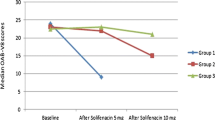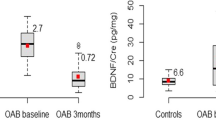Abstract
Introduction and hypothesis
The aim of this study is to investigate changes in urinary nerve growth factor (NGF) and prostaglandin E2 (PGE2) in women with overactive bladder (OAB) following anticholinergic treatment.
Methods
A total of 30 female patients with OAB were enrolled and the control group included 15 healthy women who did not present any bladder symptoms. All subjects with OAB recorded voiding diaries, underwent urodynamic study, and were evaluated for urgency grade. They received anticholinergic treatment for 4 weeks, after which they were again evaluated for urinary urgency grade and voiding diaries. OAB patients were classified into three groups according to the change on the 5-point Urinary Sensation Scale after the treatment: group 1 (no change in urgency grade), group 2 (1 point of improvement), and, group 3 (more than 2 points of improvement). Urinary NGF and PGE2 levels between controls and OAB patients (before and after treatment in groups 1, 2, and 3) were compared.
Results
Urinary NGF and PGE2 levels were significantly higher in OAB patients than in the controls. NGF levels were not significantly different between pre- and post-treatment in groups 1 and 2. However, in group 3, NGF levels were significantly decreased after treatment. PGE2 levels were not significantly different between pre- and post-treatment in either group.
Conclusions
NGF and PGE2 have important roles in the development of OAB symptoms in women. Initial reduction of urgency severity after anticholinergic treatment in women with OAB could be associated with decreasing urinary NGF levels.



Similar content being viewed by others

Abbreviations
- NGF:
-
Nerve growth factor
- PGE2 :
-
Prostaglandin E2
- OAB:
-
Overactive bladder
References
Irwin DE, Milsom I, Hunskaar S et al (2006) Population-based survey of urinary incontinence, overactive bladder, and other lower urinary tract symptoms in five countries: results of the EPIC study. Eur Urol 50:1306–1314
Stewart WF, Van Rooyen JB, Cundiff GW et al (2003) Prevalence and burden of overactive bladder in the United States. World J Urol 20:327–336
Steers WD, Tuttle JB (2006) Mechanism of disease: the role of nerve growth factor in the pathophysiology of bladder disorders. Nat Clin Pract Urol 3:101–110
Lowe EM, Anand P, Terenghi G, Williams-Chestnut RE, Sinicropi DV, Osborne JL (1997) Increased nerve growth factor levels in the urinary bladder of women with idiopathic sensory urgency and interstitial cystitis. Br J Urol 79:572–577
Maggi CA (1992) Prostanoids as local modulators of reflex micturition. Pharmacol Res 25:13–20
Park JM, Schnermann JB, Briggs JP (1999) Cyclooxygenase-2. A key regulator of bladder prostaglandin formation. Adv Exp Med Biol 462:171–181
Bultitude MI, Hills NH, Shuttleworth KE (1976) Clinical and experimental studies on the action of prostaglandins and their synthesis inhibitors on detrusor muscle in vivo and in vitro. Br J Urol 48:631–637
Kim JC, Park EY, Hong SH, Seo SI, Park YH, Hwang TK (2005) Changes of urinary nerve growth factor and prostaglandins in male patients with overactive bladder symptom. Int J Urol 12:875–880
Kim JC, Park EY, Seo SI, Park YH, Hwang TK (2006) Nerve growth factor and prostaglandins in the urine of female patients with overactive bladder. J Urol 175:1773–1776
Sussman DO, Kraus SR, Carlsson M, Guan Z (2007) Onset of efficacy of tolterodine extended release in patients with overactive bladder. Curr Med Res Opin 23:777–781
Dmitrieva N, Shelton D, Rice AS, McMahon SB (1997) The role of nerve growth factor in a model of visceral inflammation. Neuroscience 78:449–459
Clemow DB, Steers WD, Tuttle JB (2000) Stretch-activated signaling of nerve growth factor secretion in bladder and vascular smooth muscle cells from hypertensive and hyperactive rats. J Cell Physiol 183:289–300
Steers WD, Kolbeck S, Creedon D, Tuttle JB (1991) Nerve growth factor in the urinary bladder of the adult regulates neuronal form and function. J Clin Invest 88:1709–1715
Steers WD, Ciambotti J, Erdman S, de Groat WC (1990) Morphological plasticity in efferent pathways to the urinary bladder of the rat following urethral obstruction. J Neurosci 10:1943–1951
Okragly AJ, Niles AL, Saban R et al (1999) Elevated tryptase, nerve growth factor, neurotrophin-3 and glial cell line-derived neurotrophic factor levels in the urine of interstitial cystitis and bladder cancer patients. J Urol 161:438–441
Giannantoni A, Di Stasi SM, Nardicchi V et al (2006) Botulinum-A toxin injections into the detrusor muscle decrease nerve growth factor bladder tissue levels in patients with neurogenic detrusor overactivity. J Urol 175:2341–2344
Persson K, Sando JJ, Tuttle JB, Steers WD (1995) Protein kinase C in cyclic stretch-induced nerve growth factor production by urinary tract smooth muscle cells. Am J Physiol Cell Physiol 269:C1018–C1024
Andersson KE (2002) Bladder activation: afferent mechanisms. Urology 59:43–50
Andersson KE (1993) Pharmacology of lower urinary tract smooth muscles and penile erectile tissues. Pharmacol Rev 45:253–308
Schüssler B (1990) Comparison of the mode of action of prostaglandin E2 (PGE2) and sulprostone, a PGE2-derivative, on the lower urinary tract in healthy women. A urodynamic study. Urol Res 18:349–352
Masick JM, Levin RM, Hass MA (2001) The effect of partial outlet obstruction on prostaglandin generation in the rabbit urinary bladder. Prostaglandins Other Lipid Mediat 66:211–219
Park JM, Houck CS, Sethna NF et al (2000) Ketorolac suppresses postoperative bladder spasms after pediatric ureteral reimplantation. Anesth Analg 91:11–15
Jin LH, Han JU, Park CS, Shin HY, Yoon SM, Lee T (2010) Intravesical PGE2 administration in conscious rats as an experimental model of detrusor overactivity observed by simultaneous registrations of intravesical and intraabdominal pressures. Int Neurourol J 14:69–77
Ikeda M, Kawatani M, Maruyama T, Ishihama H (2006) Prostaglandin facilitates afferent nerve activity via EP1 receptors during urinary bladder inflammation in rats. Biomed Res 27:49–54
Schröder A, Newgreen D, Andersson KE (2004) Detrusor responses to prostaglandin E2 and bladder outlet obstruction in wild-type and EP1 receptor knockout mice. J Urol 172:1166–1170
Digesu GA, Khullar V, Cardozo L, Salvatore S (2003) Overactive bladder symptoms: do we need urodynamics? Neurourol Urodyn 22:105–108
Nitti VW, Rovner ES, Bavendam T (2010) Response to fesoterodine in patients with an overactive bladder and urgency urinary incontinence is independent of the urodynamic finding of detrusor overactivity. BJU Int 105:1268–1275
Liu HT, Chen CY, Kuo HC (2011) Urinary nerve growth factor in women with overactive bladder syndrome. BJU Int 107:799–803
Conflicts of interest
None.
Author information
Authors and Affiliations
Corresponding author
Rights and permissions
About this article
Cite this article
Cho, K.J., Kim, H.S., Koh, J.S. et al. Changes in urinary nerve growth factor and prostaglandin E2 in women with overactive bladder after anticholinergics. Int Urogynecol J 24, 325–330 (2013). https://doi.org/10.1007/s00192-012-1854-4
Received:
Accepted:
Published:
Issue Date:
DOI: https://doi.org/10.1007/s00192-012-1854-4



